Exploring the world of independent watchmaking, it doesn’t take long before you start learning about Svend Andersen. A master watchmaker and founder of the AHCI who spent several years at Patek Philippe after creating his legendary Bottle Clock, Svend Andersen has been operating as a true independent watchmaker since 1980.
I was incredibly fortunate to be able to speak with him recently via video call in his atelier in Geneva, and after a virtual tour to see the facilities and meet the team, I was able to speak with him and learn more about his incredible career.
In Conversation with Svend Andersen
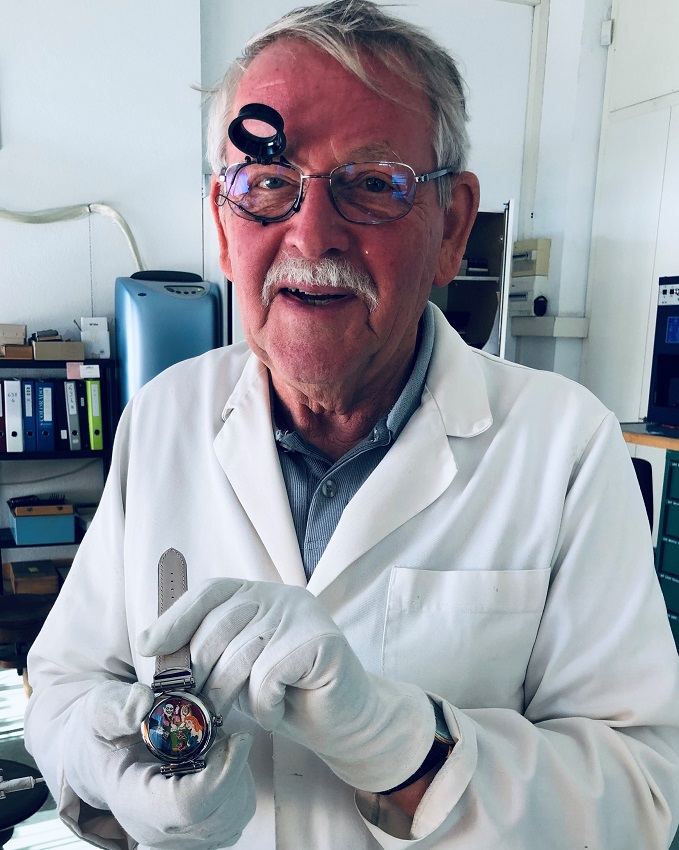
Svend Andersen, photo – Andersen Genève
WA: After graduating from Watchmaking School in Copenhagen, you moved to Switzerland in 1963 to get experience in the world of Swiss watchmaking. After only six years in Switzerland, you found yourself working at Patek Philippe’s “Atelier des Grandes Complications”. This must have been a real whirlwind six-year journey – to start with, can you tell me about those early years of your career?
SA: I learned to be a watchmaker in Denmark, however it was only for after sales service – there was no watch industry and no watchmaking in Denmark, so therefore I said I will go to Switzerland so I can see how watches are made. I got some offers for a place in Switzerland, but I discovered that in the factories they didn’t pay very well, and when I told them I could speak German and English at that moment, in the retail shops they paid almost twice because I could speak English. This was very much in demand at that moment because most of the customers were Americans in the sixties.
So, I came to a small shop in the Valais Region near the mountains – I really wanted to come to the mountains from flat Denmark, so I came to a shop there where the tourist buses came with American tourists, where they came mostly from Italy or were going to Italy. On their way, they stopped in this small town called Brig and they went to the watch shops there. This was in the summertime, but in the winter I went to Saas Fee, and I two or three weeks at once before I went back to Brig because Saas Fee had a lot of tourists because that’s where it was interesting to be.
There, I met a guy who was working for Gübelin in Lucerne, and he told me “Come to Lucerne, it’s a very nice town, a big company, there’s many more possibilities here”, and so I went to Gübelin in Lucerne, to be in the same shop with the customers. The salesman couldn’t answer all the technical questions, so they needed a watchmaker to do that. After one and a half years, I went to the Gübelin shop in Geneva, and there I spent five years.
And there we come to the six years! I came to Patek Philippe because I put the clock into the bottle – they discovered a watchmaker able to something very special, and they asked me to come to them.
WA: When you first moved to Switzerland, did you have in mind to stay in Switzerland for as long as you have?
SA: No no! (laughs) I had no idea at all! I went there, and I must say one thing – I met my future wife in Lucerne, and she was working as a German, English and French correspondent, and she wanted to go to the French speaking part of Switzerland, and therefore I came also to Gübelin in Geneva – we came together. Yesterday it was 55 years since we were married!
WA: Congratulations – that’s amazing!
SA: Yes! Thank you!
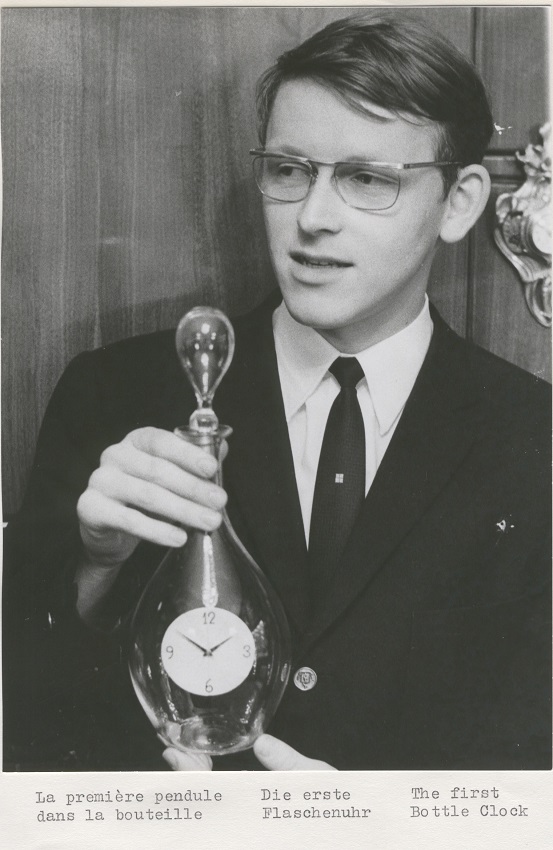
Svend Andersen and his bottle clock – photo, Andersen Genève
WA: As you just mentioned, before you joined Patek Philippe, you showcased your wonderful Bottle Clock at the “Montres et Bijoux” exhibition – something which certainly got the watch world talking! Firstly, where did the idea for this come from, and secondly, what was most challenging about the process to create the first one?
SA: The idea came at a New Year’s Eve party when I saw my table clock through an empty bottle! That was the idea, and maybe also because I come from Denmark, and where I come from, they have a museum with a big collection of bottle ships, so maybe it could be that too.
Then I had to study how I could put a clock movement into a bottle, through a bottle neck opening of between 18 and 20mm. So, I had to make the tools also, because nothing existed – long screwdrivers or whatever. You also have to replace your fingertips because you couldn’t touch the parts in the bottle. I studied all this, and I made the tools… and they are still here!
WA: How long did it take you to make the first one after you had the idea?
SA: A little less than one year.
WA: Wow! I can see why Patek Philippe took you on, that’s very impressive! I understand that you continued to make Bottle Clocks for collectors whilst working for Patek Philippe, and ultimately the network you built up in doing this helped you when you started Andersen Genève several years later. Looking back now, did you have any idea that the Bottle Clock would have such a huge impact on your career?
SA: The Bottle Clock opened the doors to the collectors’ world, and the collectors’ world at that moment was not the same as the collectors’ world is today. The collectors’ world was a little more closed, more confidential you could say.
At that moment when I made the bottle clock, I presented it here and the next day it was on the front page of the local newspaper. In the afternoon, I was interviewed by the local radio, and in the evening, I was on Swiss television! That was the first day, and then other days it was picked up by Reuters news agency from the Swiss news agency, and it went around the world within one week which is something exceptional at that moment because the internet did not exist – it was In the late 60’s.
I got letters from the United States, from Hong Kong, from all over the world, but mostly from the United States. They were amazed by it, and they named me “the watchmaker of the impossible”!
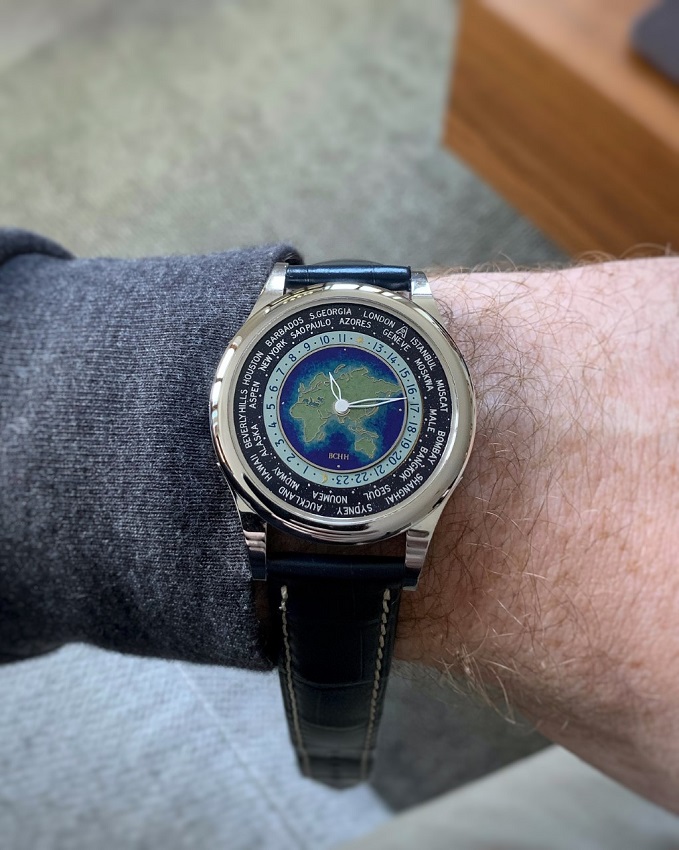
Andersen Genève World Timer
WA: It is incredible to think that at that time, word spread around the world so quickly.
SA: You cannot compare anymore what it was like at that moment. I am also very thankful to my wife, for she as a French German English correspondent, she was able to write the letters that we sent all around the world! Without her help, I think I would not be here today in the same position as I am today. This also concerns the AHCI – she was the secretary there for 17 years. It’s like a watch, everything works together!
WA: What were some of your personal highlights during your time working at Patek Philippe during the 1970s? What kind of projects did you get to work on?
SA: Of course, I arrived at the most exclusive atelier of Patek Philippe – the “Atelier des Grandes Complications”. So, I had to work with perpetual calendars, chronographs, repeater movements, and we did a lot of restoring old, important Patek Philippe watches, mostly complicated pocket watches.
Also, I got to work with parts of World Time watches, because Cottier, Louis Cottier, made the most important World Time watch for Patek Philippe. They had some parts and they wanted to know how we can put them together to make some watches – could we finish some watches from those parts? Mr. eBerney, the boss in the atelier, he gave me the task to find out what is there.
I found it was excellent, because it is also able to create a very nice dial to put on artworks, to make something very beautiful with this kind of watch. You can put artwork on the world time watch as we do today, as Patek did also in the past, so I learned this also.
I also learned restoring old watches – in restoring watches you can learn a lot, because you can see what has been done in the past. As we say, you cannot advance when you don’t know about the past.
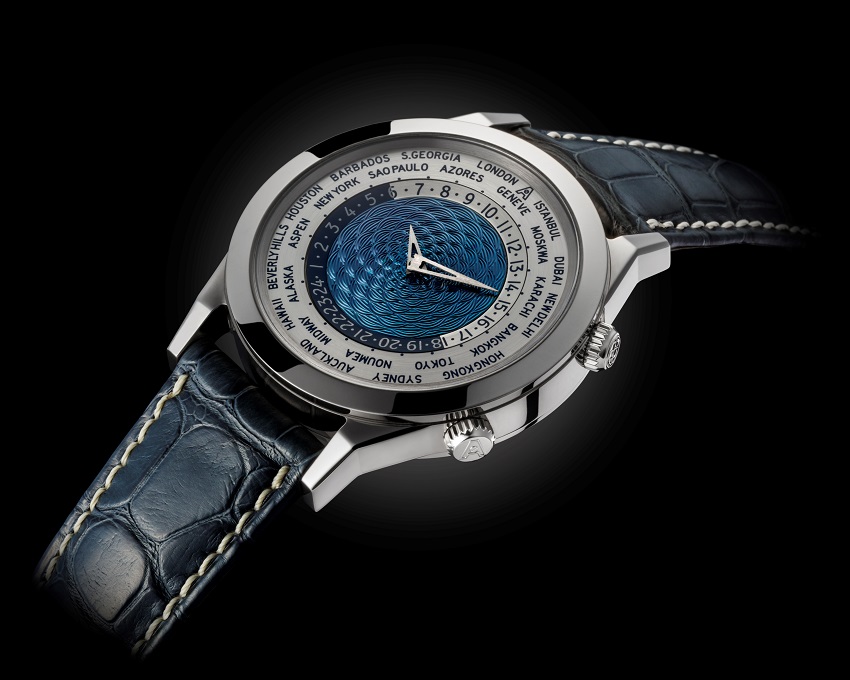
Andersen Genève World Timer – photo, Andersen Genève
WA: So, when you made the decision to start your own workshop in 1980, just as the Quartz Crisis started, you worked with pocket watches and making cases for them as you had done at Patek Philippe. How did you find the transition from working at Patek Philippe to becoming a full-time independent watchmaker? What was the best, and the most challenging things about this change?
SA: Well, it was not difficult because I came into the collectors’ world as I mentioned before. One collector came with a very complicated pocket watch movement, but it had no case anymore. He said to me, “if you can put a clock into a bottle, can you not make a case for this very nice movement?” I was still working for Patek Philippe, but I said, “why not?”
I never say no when somebody asks me something, I just think about is it possible or not.
I had no idea how to make a case, so I was studying some cases by Patek, and I also had contact with the Geneva watch museum, the library, so I went there and studied how cases were made. I designed a case for this collector gentleman, and I had it made with a casemaker – one of the last casemakers able to make pocket watch cases – and I delivered the watch to the collector.
He was from the German part of Switzerland, and he was very very happy. He went to a collectors’ meeting in Münich, where he put his watch in the centre of the table and everyone was asking “wow what is that!”
It started with this in 1978, and then from all around the world they came with complicated pocket watch movements, and they wanted different styles of cases and it was very interesting work. I started working with the Geneva watch museum to what kind of styles to use in collaborations. Also, when I don’t know, I ask! This is how you progress!
WA: After a few years of working with pocket watches, you then started to create more wristwatches; the first wristwatch produced under your Andersen Genève brand was a World Timer in 1989. Given your time at Patek Philippe working with Louis Cottier’s world timer complication, there is a nice symmetry with a World Time being your first watch. Was this a deliberate choice on your part? And how did it feel to finally see a wristwatch with the name Andersen Genève on the dial?
SA: Well, I had already made watches before with Andersen Genève on the dial, because as you said, I started to make wristwatches by the mid-1980s. Collectors came, mostly from Italy, and they didn’t want quartz watches. I started to make cases for them, designed dials, sometimes they had movements, sometimes I had mechanical movements for sale, and so we started with this. It was very interesting especially with the Italians, because they had good ideas about style, they wanted something very nice, and so it was a very good school for doing designs for the Italian customers.
Then, I thought it would be useful to have a World Time watch, so I started thinking about this and then I remembered the World Time mechanism from Cottier was very thick. Including the dial, it was 2.5mm thick so it was not very elegant as a complication. Therefore, I made a World Time module which is only 0.9mm thick including the dial. This module is still in our World Time watches we make today – it’s the same principle and the same thing, but updated. This World Time module can be put on minute repeaters, automatic watches – everywhere!
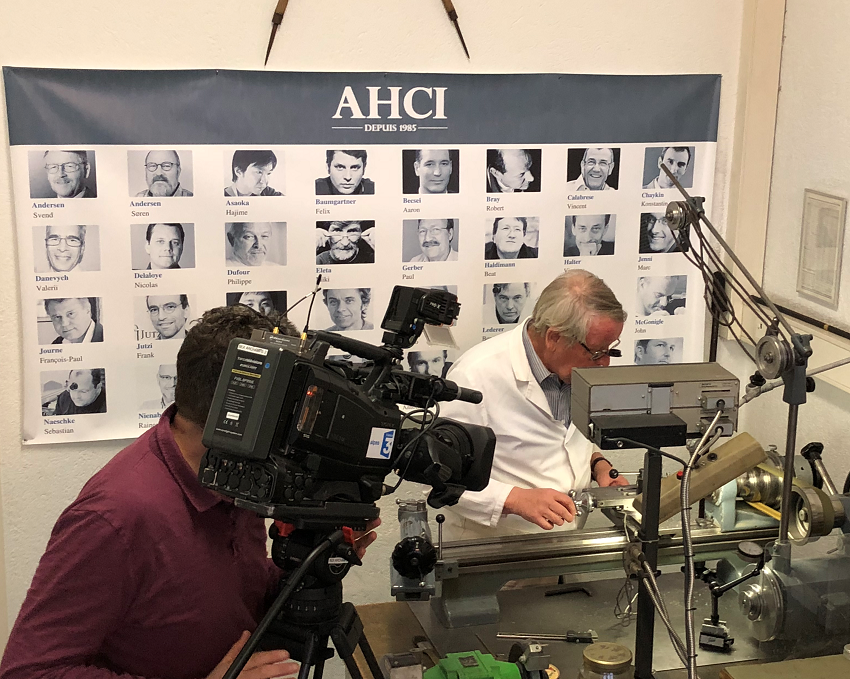
Svend Andersen with an AHCI members banner including Philippe Dufour, Konstantin Chaykin, Vianney Halter, F.P. Journe and more – photo, Andersen Genève
WA: As we touched on earlier, in 1985, you co-founded the AHCI, the “Académie Horlogère des Créateurs Indépendants” with Vincent Calabrese to help support independent watchmakers. Today, the members list reads like a who’s who of independent watchmaking. In 2010, the AHCI was awarded the Special Jury Prize at the GPHG Awards – what did this recognition mean to you, especially in the AHCI’s 25th anniversary year?
SA: It was to recognise our efforts, and also when we started at the beginning in 1983, 1984, 1985, after the quartz crisis one did not know which direction watchmaking will go. As I said before, Italian collectors came and they wanted mechanical watches, and then we found out that there were Germans, English, from elsewhere they wanted it also.
We saw that financial groups bought old factories in the Jura mountains which had stopped producing, and some of the financial group and bankers asked us “can you develop a mechanical watch for us?” and they also wanted to collaborate with us and other independents. And we said OK, and we wanted to find a way to have a place in this new “watch world”, if we could call it that.
We realised we have to go together – the more you are, the stronger you are, so we had to be more. Here around us, we had 8 of us together at the first meeting. Most of them were not open to the world, they couldn’t imagine how to contact the customers – they saw the world through their watchmaker’s eyeglass!
I said we must work bigger. So, my wife as I told you before she was the secretary for the first 17 years, she made a press release in German, French and English, and Vincent Calabrese did it in Italian. We sent this press release to the watch magazines… how many watch magazines do you think existed at that moment?
WA: I have no idea… 2 or 3 maybe?
SA: There were 12! We asked that at the Basel Fair, they publish, and I think 7 of them published the press release, and then we grew to 10 or 11 watchmakers who wanted to come together with us.
And then, one morning, I get a letter from England. I opened it, and it said “I want to join your group. Signed, George Daniels” and I said “now, we are on the right way forward!” It was in 1985, so I can say that in 1985 the AHCI was founded in Geneva.
Also, you may know that we are preparing a very big exhibition in Geneva for the end of this month – the masters of horology – and it seems that a lot of people will come so it should be a great event!
WA: Yes, it looks like it will be awesome! I would have loved to have been able to come but I can’t get to Geneva unfortunately for it, I am excited to see what is announced! To this end, through Andersen Genève, you have created some incredible and complicated pieces over more than 40 years, from the Secular Perpetual Calendar to Eros automatons, and the Montre à Tact inspired by Breguet. What is it that drives and inspires you to create such complicated watches and why?
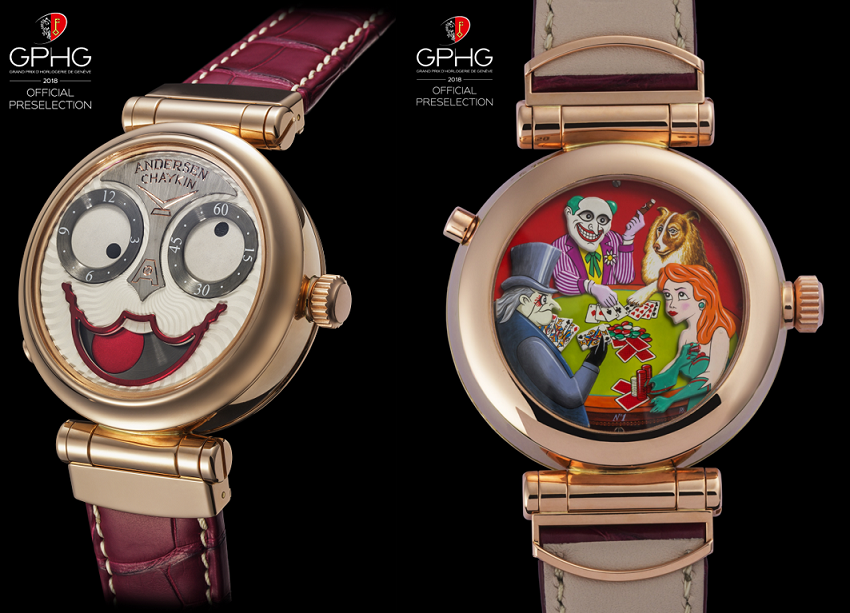
Svend Andersen x Konstantin Chaykin Joker Automaton – photo, Andersen Genève
SA: I have made so many cases and watches because people ask me! They come to the “watchmaker of the impossible” for the impossible! You can take the automatons, the Montre à Tact… maybe the Secular Calendar was myself because I wanted to make a challenge.
I was working together with the technicians who were preparing the calibre 89 from Patek Philippe and it was a big pocket watch, and there, they had the secular perpetual calendar inside. But they had so many wheels and big wheel trains, to come down to one wheel which turns once every 400 years!
It would have never placed into a wristwatch, so I found a mechanism for a secular indicating wheel train which fit into a mechanism of 30mm diameter – it was a challenge! It is still the only wristwatch with secular calendar on the market.
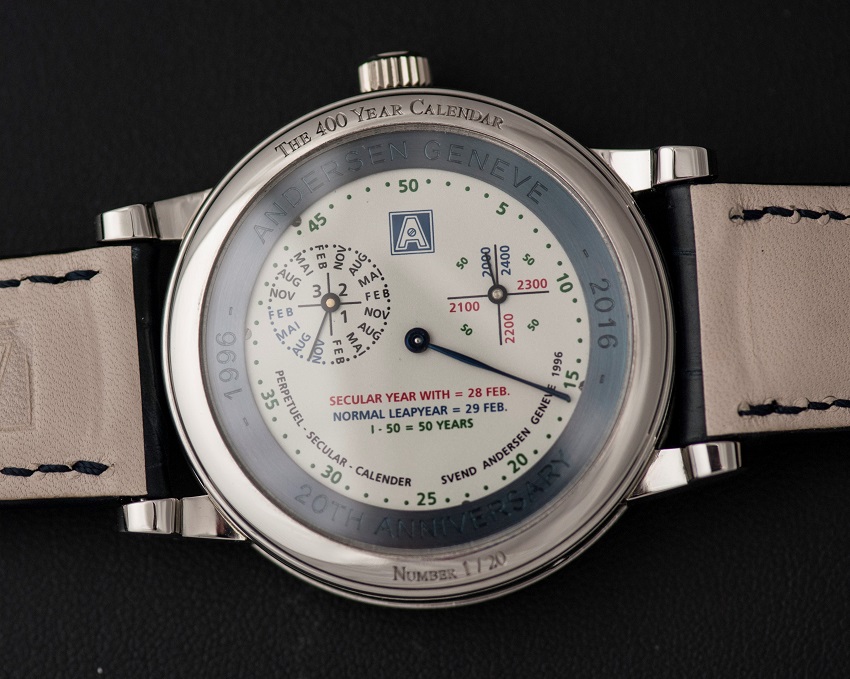
Svend Andersen's Secular Perpetual Calendar – photo, Andersen Genève
WA: So a lot of the watches that you make are either a challenge from a collector, or a challenge from yourself?
SA: Yes – with most from the collectors, from the outside.
WA: If the work of Breguet inspired the Montre à Tact, are there any other watchmakers form history that really inspire you as well?
SA: One who inspired me very much was George Daniels, he became a very good friend of mine. He inspired me very much as a watchmaker, but also mentally. He was a good example.
I have read a lot of books on the history of watchmaking so also the people in Glashütte – Lange, the way they grew. Lange started in a small village where nobody had any idea about watchmaking. He built up something fantastic there, and so it’s not just the technical but also the people behind it. It is very important that you have an idea in your mind – when you don’t have something good in your mind, you can’t do it with your hands.

Andersen Genève Montre à Tact
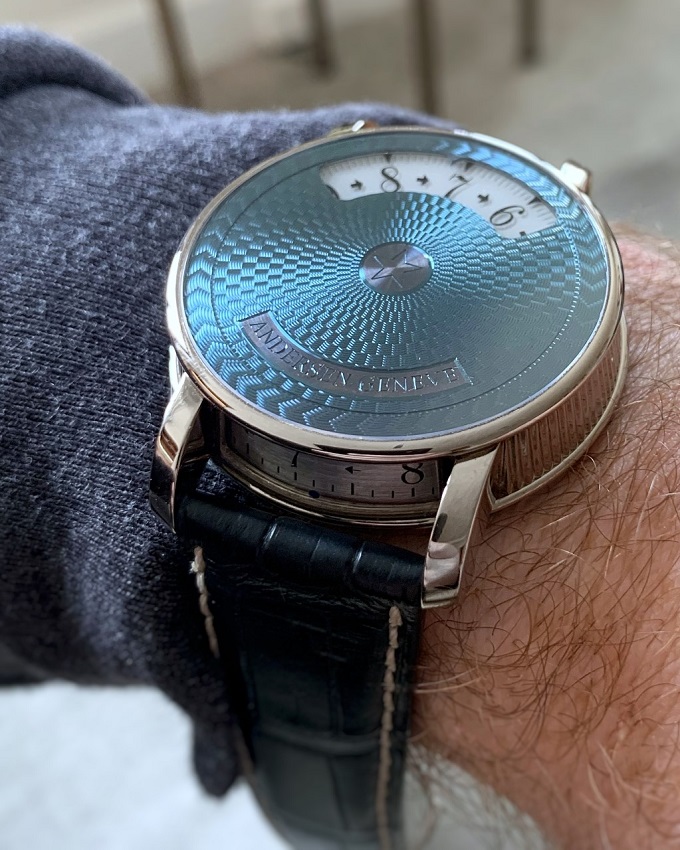
Andersen Genève Montre à Tact hidden time display
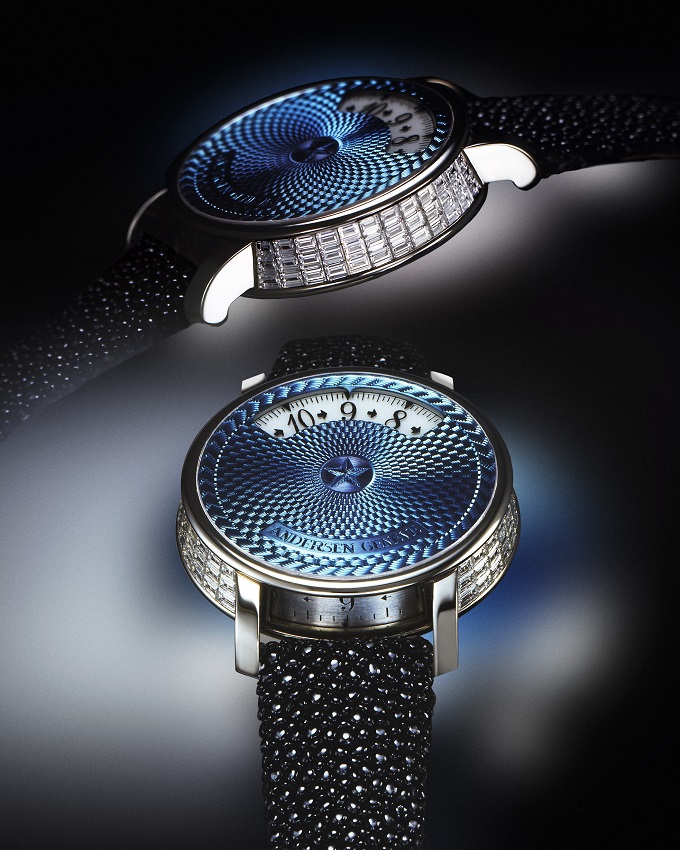
Andersen Genève Montre à Tact – photo, Andersen Genève
WA: Right now, it is a very exciting time for independent watchmaking, with many independent brands more popular now than ever before. What are your thoughts on the rise of interest in independent watchmaking, and what do you hope to see come from it?
SA: With independent watch brands now, every time you open watch magazines, you see 1 or maybe 3 new brands presenting their new watches there. Sometimes, you see the people behind them are not watchmakers, they are very good in business.
They create a brand, and they get them made by some companies working “behind the curtain” as we say, to make the movements and have nothing to do with the watches. Many of these brands are “pure-marketing” brands.
Therefore, the members of the AHCI and other independent watchmakers, who make their watches by themselves – they create, they develop their watches, they must defend this position because you have new watch brands selling a Swiss tourbillon for less than 6000 Swiss Francs, but when you see exactly what is inside, you can say “OK, what is Swiss?”
It’s assembled in Switzerland, but the parts are not Swiss, it’s impossible. In the AHCI, a tourbillon movement is made by hand, and you would ask 50,000 Francs – this is really made by himself. I read an article about Daniel Roth recently, he made tourbillons entirely by hand. He is not a member of the AHCI, but that is really craftsmanship.
I hope that the independent watchmakers who are really watchmakers can be there to show the difference.
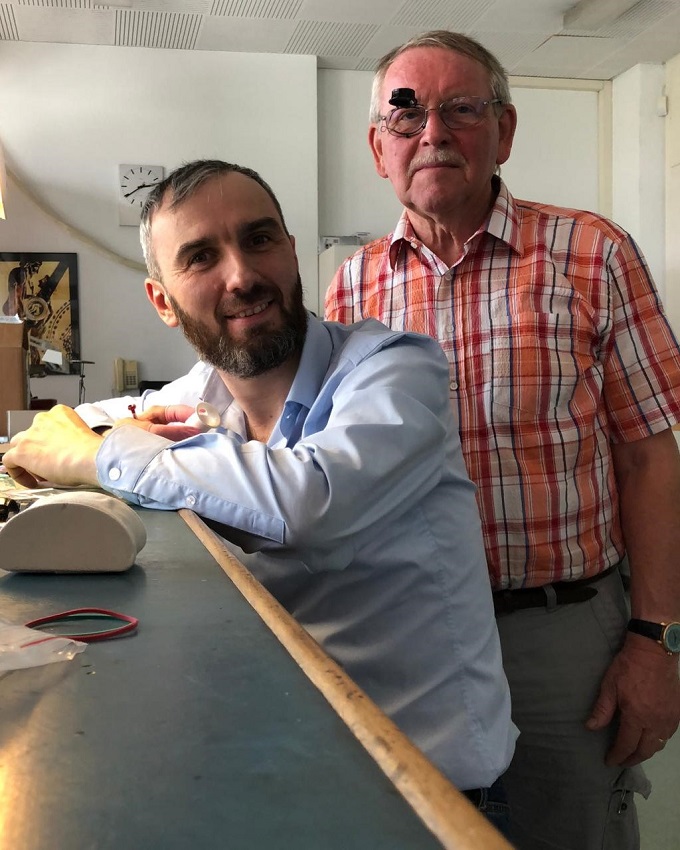
Master Watchmakers Svend Andersen & Konstantin Chaykin – photo, Andersen Genève
WA: Like a hope that the rise in interest in independent watchmaking also learns to recognise the exceptional skill and handcraft that goes into the likes of the independents in AHCI for example.
SA: Yes, we have to defend this and explain this, I can explain but many of my colleagues are not able to explain so therefore we must help them. We are very dependent on journalists also to help us to explain. It’s very important.
Without the journalists, the AHCI would not be where we are today, because at the beginning they came to us, and they discovered us – they discovered the quality of our watches, and they came at the Basel Fair every year.
Every year, all the journalists came to us, and they wrote fantastic articles, and thanks to them we had a very good chance to be known worldwide – we had no advertising in the magazines.
WA: Finally, if you could share one piece of advice from your incredible career with an aspiring young watchmaker, what would you say?
SA: When somebody asks something that is nearly impossible, don’t say “no I cannot”, you have to say, “OK I will study this”. And when you don’t know you have to ask! The final thing is to know that half of all the work is to organise it!
WA: Thank you very much for taking the time to speak with me!
SA: You are welcome!
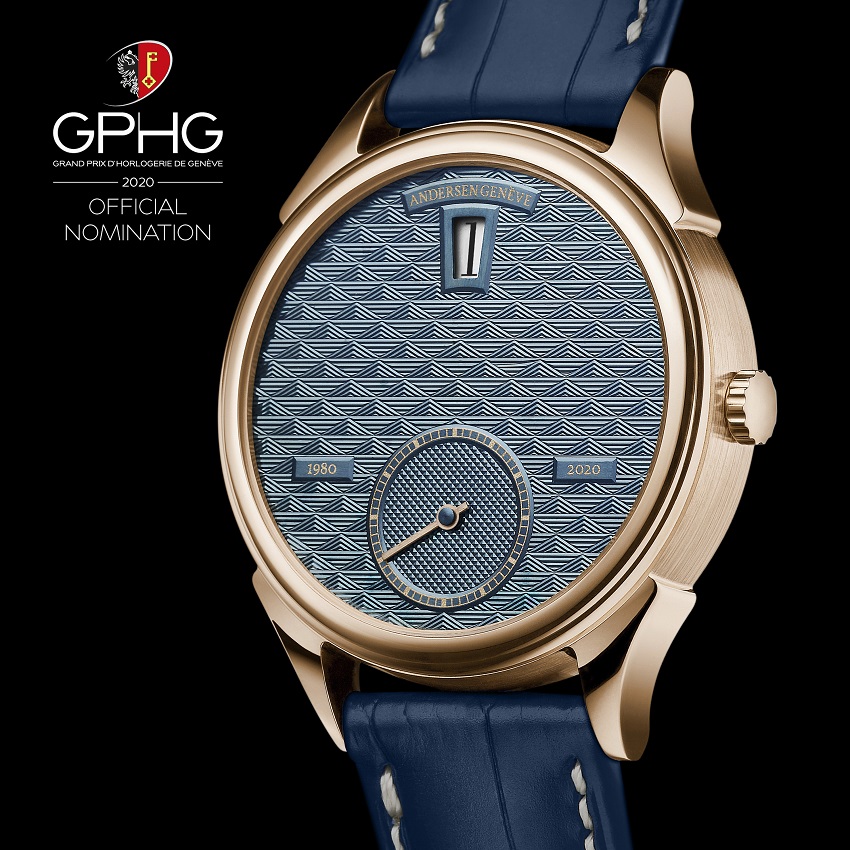
Svend Andersen's Andersen Genève Jumping Hour 40th anniversary – photos, Andersen Genève
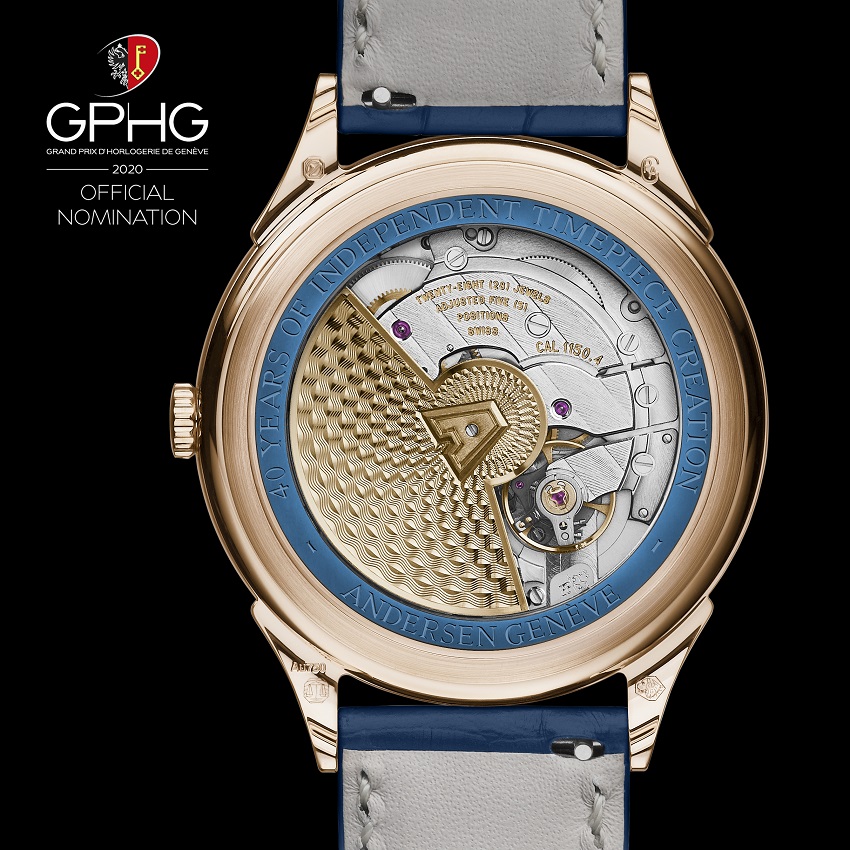
To learn more about Svend Andersen and Andersen Genève, please visit Andersen-Geneve.ch or our partners at The Limited Edition. Be sure to also visit the AHCI website at AHCI.ch.
Remember to mention “Watch Affinity” when speaking with the team at The Limited Edition to receive a small gift with any Svend Andersen / Andersen Genève order!
Share your thoughts with us via our Contact page, or via our Instagram
Don’t forget to check out the Interviews Page for more!
You might also be interested in:
- Independent Watchmaking – An Ode to the Indies
- Recommended Reading: ‘The Independent Spirit: Time makers since 1985’ by AHCI
- Influential Watchmakers: Abraham-Louis Breguet
- Watch Stationery and Gift Ideas
- Watch Books, Watch Boxes and more at the Watch Affinity Shop on Amazon (commissions earned)
As an Amazon Associate, I earn from qualifying purchases – thank you for your support

